Read Like a Writer!
/As a writer, sometimes the pressure to constantly make progress on your book can prevent you from enjoying other things in life. Maybe all you want to do is sit down, relax, and open a fun book to read without worrying about your word count. If your attempts to do this are met with a voice in your head that tells you how reading for fun is a waste of time or unproductive, then you need to realize that voice is WRONG.
Reading is one of the best uses of time for a writer at any level, or in any genre. It is the foundation of the entire craft; it is the inhale of knowledge, experience, and inspiration that is later breathed onto a new page. A writer who does not read regularly will be at a severe disadvantage compared to a widely read writer who can draw on that wealth of experience to hone their craft.
Books on Writing
This one may seem fairly obvious, but there are some truly fantastic books out there specifically intended to help writers of all kinds bring their work to the next level. These types of books are a repository of lifetimes of writing experience distilled into easily digestible paperbacks. My personal favorite books on writing are On Writing, by Stephen King, Save the Cat, by Blake Snyder, and Reading like a Writer, by Francine Prose. The latter of these focuses on close reading, the practice of slowing down and looking more critically at the individual elements of written work in order to pinpoint what makes a particular passage either come alive or fall flat.
This process of close reading pairs especially well with our last blog post “Keeping a Writer’s Notebook.” When practicing close reading, try to identify how a particular sentence or passage makes you feel on the first read, then go back and look for what the author did exactly with their prose in order to accomplish that effect. Then, jot it down in your writer’s notebook so that you have a concrete example for how to illicit that emotion in a reader. You can do this on any page in almost any book, and you will probably learn something new from it. There are a million different applications for this concept, but most of them you will have to discover for your own through practice!
Books for Fun
Whether you enjoy fiction, non-fiction, or maybe even children’s books, it is important to stay plugged in and continue exploring and enjoying new books. For a lot of us, the inspiration for our first or current book came from something else we read, but that discovery doesn’t have to stop after a single idea. Keep reading, keep imagining new stories or ideas, and jot them all down in your notebook. It is easier to be creative when you are enjoying yourself, and often the solution to a bad bout of writer’s block isn’t staring at your computer screen for longer, but getting lost in a book you love.
Rereading books you already love is also a fantastic application for close reading. It will allow you to recognize specifically how the author created these scenes or characters you hold dearly, and then you can begin to implement some of the techniques you identify into your own writing. Even if you aren’t rereading passages with a fine-toothed comb and taking notes, you will still be expanding your knowledge just by spending time in books.
So, the next time you are writing and find yourself at a loss for words, don’t hesitate to step away from the keyboard and pick up a book instead. Rather than viewing reading as a luxury or a break away from writing, try to view it as a complement to your work that can refresh your mind and reinvigorate your creativity. Your editor will thank you for it.
Tim and the Inspira Team


